
You’ve probably seen photos of endless lavender fields, tanned vacationers strolling Mediterranean beaches and promenades, and couples sipping Provençal rosé wines on countryside villa terraces. That’s the Provence, France, of spring and summer most well-known to travelers.
Those are all beautiful sights to see and activities to enjoy in this part of southern France, but Provence shines as a travel destination during any season. During our recent trip, my husband and I found December to be a great time to visit. It was exciting to experience Provence at a time of year so special to the people of the region. We were able to observe unique Christmas traditions, enjoy hearty winter cuisine, and also discover enough things to do and sights to see to inspire us to return.
Celebrating the traditions of Provence
The Christmas season in Provence, which begins on December 4th and officially ends on Candlemas (February 2nd), is a particularly enticing time to visit. The region’s traditions and seasonal activities rival those of venues perhaps better-known for Christmas attractions. In a less tourist-intense time (compared to spring and summer), we felt we were able to more easily see the sights and, in a more open and relaxed way, meet the people.
With all of the frantic activities that consume the holidays for many people, taking a step back from the frenzy to focus on and appreciate tradition was a pleasant change. In Provence, we experienced a pre-Christmas steeped in cultural and gastronomic traditions (some that go back many centuries) and centered on family and friends. We spoke to many people about how they kept Christmas in their homes. Everyone talked about the old Provençal traditions. Most still observe them while also incorporating contemporary ones, such as those of Santa Claus and decorated Christmas trees.
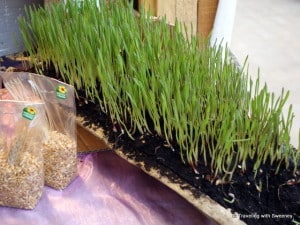
Planting the seeds
The Christmas festivities begin on December 4th with the Feast of St. Barbara. On this day, people plant wheat or lentil seeds in dishes. The legend is that these seeds give hints as to what the new year will hold. If they sprout, the harvest will be good. How high the wheat has grown by December 25th signifies just how prosperous a year one can expect. The dishes of fresh green sprouts were on display in many places we visited and are also traditional adornments for the Provençal Christmas Eve dinner table.
The art and craft of santons (the “little saints”)
Starting our trip in Marseille, we walked about the Foire aux Santons, an annual fair and market on the picturesque old port. It’s specifically for showcasing santons, one of the key Provençal Christmas traditions.
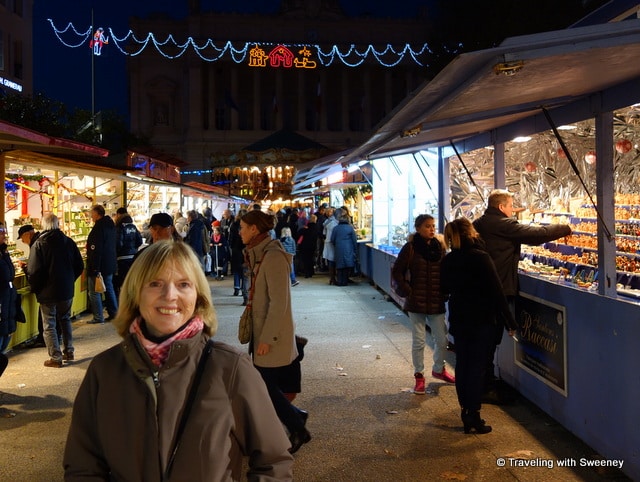
Handcrafted by local artists (santonniers), santons are clay figurines that were initially the principal characters in crèches, but as the tradition evolved they came to also be used to depict many characters and scenes of everyday life in 19th century Provence. The making of santons is both an art and a specialized craft passed down through the generations.

We saw many designs from detailed and lifelike to abstract—with sizes ranging from 2-25 cm and styles ranging from doll-like santons habillés (clothed figures using real cloth) to santons d’argile (completely clay figures). Included as well were those that were already painted and conversely, santons of plain terra cotta for people who wanted to incorporate their own artistic skills.
The range of occupations represented in Provençal santons is wide and varies by location, showcasing the local occupations of the 19th century. Gypsies, bakers, butchers, fishermen, priests, tambourine players, singers, nurses, and so many more reside in the Provençal crèche as santons of characters from traditional nativity scenes. Most people with whom we spoke had a favorite character, and for many it was the village fool: Le Ravi.
Watching entire families as they excitedly and carefully examined the many choices before making their selection was a refreshing change from the commercial excess seen so often this time of year. With just one figurine added each year (traditionally), making the selection is a serious business, but also a lot of fun. Children, some very young, were actively involved in the process, and their enthusiasm in getting just the right one was in notable contrast to the oft-seen focus on a long list of desired presents.
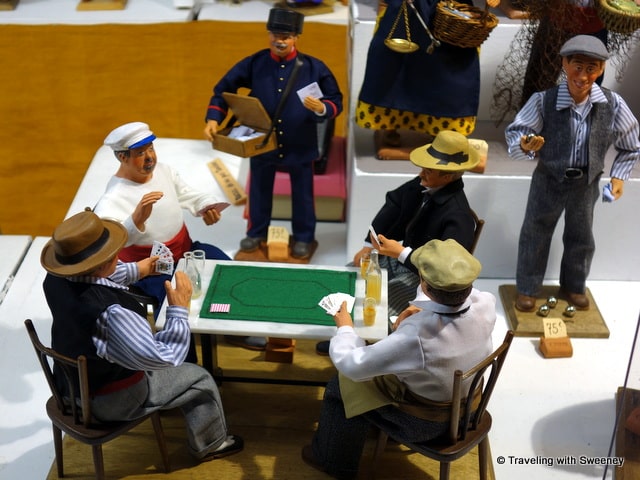
Throughout our trip, we saw santons in churches, museums, Christmas markets, tourism exhibits, storefronts, and in many other venues.
In Arles, we toured the 57th International Fair of Santon-Makers (through January 12th) in the 12th century Cloister of Saint-Trophime. The president of the fair’s association, Philippe Brochier, who travels all over the world to learn about the santons of other cultures and countries, spent time describing key aspects of the fair and santons.
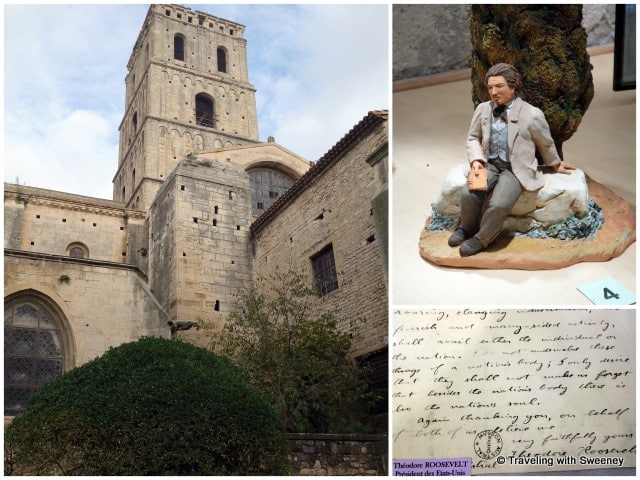
The fair focuses on the works of professional European santonniers. It also includes a competition among amateur santonniers, who each submit one work with the winner determined by the votes of visitors to the fair. The theme for this year’s competition was Frédéric Mistral, the beloved Provençal poet who was a leader in promoting and maintaining the region’s traditions and language. He won the Nobel Prize in literature for his poetry (written in Provençal), which reflects the natural scenery and native spirit of the people of Provence. He also had significant influence in promoting the importance of santons in the culture. The exhibits included several letters that Mistral received from famous people, including the one shown above from Theodore Roosevelt.
Mr. Brochier gave us a tour of the gallery showcasing the santon creations of two distinguished featured artists, Henri Vezolles (whom we met) and Liliane Guiomar.
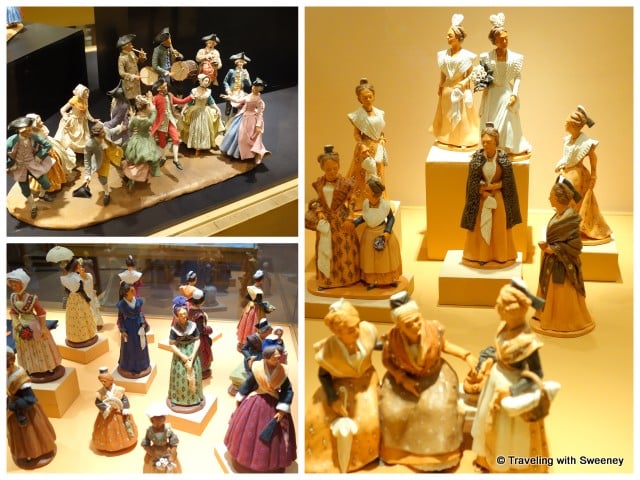
Some of the most amazing santons were those that Mr. Vezolles made completely out of clay (such as the ones in the photo above on the right). They appeared to be glazed but there was no color added; the effect of color was produced using many different-colored types of clay, a painstaking effort made even more difficult because with heat the clays expand at different rates, resulting in considerable breakage during kilning. I was really drawn to the santons of women dressed in lovely and rather complicated Arlesienne costumes of the 18th century. Each color, piece of material and accessory has a specific significance.

At the Chapelle du Collège in Carpentras we visited the annual santon fair (in its 28th year), where we saw high-quality santons of all sizes and colors (I loved the blue ones, bottom left above) as well as other creative crèche decorations. The fair also offered santon-painting workshops for children. At the tourism office in Carpentras, a large crèche attracts visitors from all over the region and beyond. This year’s themes were wine, wine-making and wood trades. It was an amazing display of scenes in forest and hillside settings.
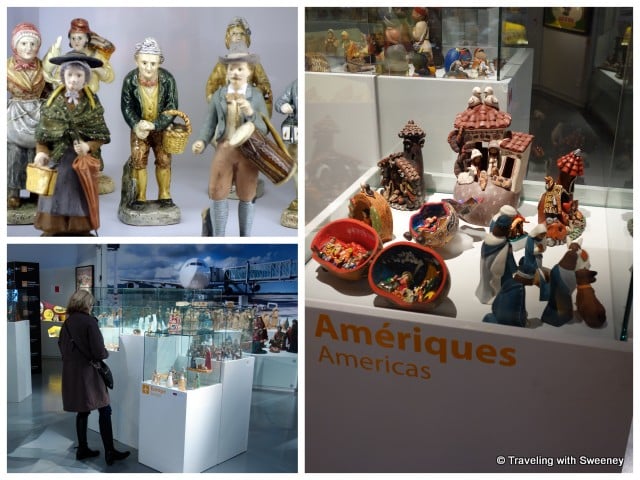
The city of Aubagne has a history as the capital of earthenware, and today it has about 30 ceramics workshops that still carry on the old traditions. Thérèse Neveu, who is considered to be the first modern santonnier, is honored in Aubagne at La Cite de l’Art Santonnier, a museum and gallery showcasing Provençal santons as well as earthenware from around the world. She is credited with inventing the technique of firing santons to make them more resistant to breakage. Her fame was enhanced greatly by the special recognition her work received from Frédéric Mistral.

The crèche in l’Eglise des Celestins on Place des Corps Saints in Avignon showcases santons created by renowned santonnier Marcel Carbonel and includes over 600 santons in a Provençal landscape, with vineyards, olive groves and hilltop villages.
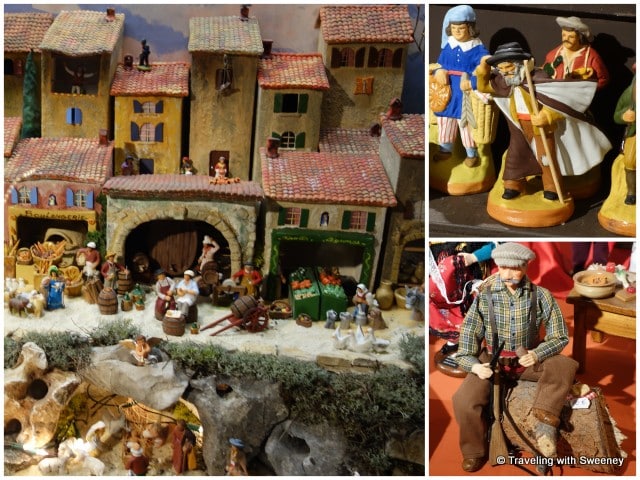
In the photos above from Salon-de-Provence, the santons on the right were on display at the santon fair at Salle Robert de Lamanon au Septier. The photo on the left captures a section of a crèche created by Henri Angiolini installed at the Musée Grévin. The entire crèche took Mr. Angiolini over 2,000 hours to make.
The sweet tradition of the Thirteen Desserts
The tastiest tradition we discovered was that of the Thirteen Desserts. As part of the traditional Provençal Christmas Eve meal, the Thirteen Desserts include a selection of Provençal fruit confit (sugar-preserved fruit) and other sweets. They are symbolic of the Last Supper (thirteen representing Christ and his 12 disciples), and also symbolize prosperity and harvest abundance. The Thirteen Desserts are served typically after Midnight Mass, hours later than the rest of the Christmas Eve meal. The tradition says that sampling each dessert accompanied with mulled wine will bring good fortune in the coming year.
The Thirteen Desserts include as a base four items that commemorate four Catholic religious orders that took vows of poverty: walnuts and hazelnuts for the Augustinians, dried figs for the Franciscans, almonds for the Carmelites, and raisins for the Dominicans.
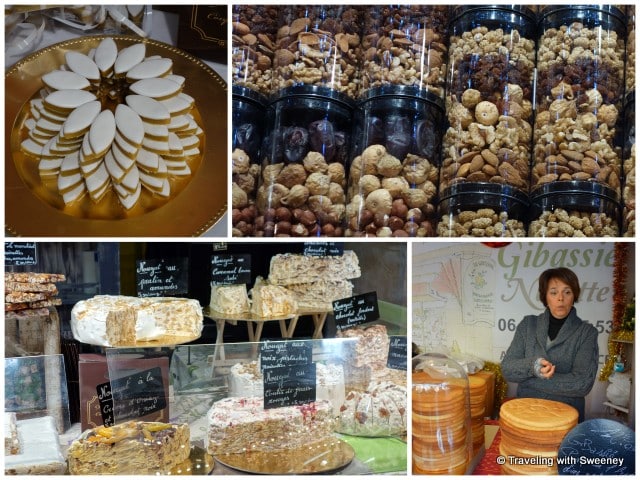
The remainder of the desserts varies across the villages of Provence (with selections emphasizing their local products), but commonly they include a combination of these treats:
- Pompe a l’huile, a flat, sweet bread made with olive oil, also known as Gibassier. It is delicious! We sampled it in Aix-en-Provence at a Christmas market booth operated by Sylvie and Pierre Piantino where we learned about the arduous 24-hour process involved in making them.
- Black and white Provençal nougat
- Calissons d’Aix, a specialty of Aix-de-Provence are pastries made of finely ground almonds, Provençal melon, and orange peel on a wafer topped with icing. The calissons come with an interesting legend of their own. It’s said that they were first created in 1454 as a special sweet for the wedding of King Rene to Jeanne de Laval. According to the story, Jeanne was a woman who never smiled, but when she tasted this sweet, she beamed a smile and asked the confectioner what they were called. He replied in Provençal: “di calins souns” (“they are little hugs”). There is also an annual blessing of calissons in Aix the first Sunday of September commemorating this and other legends about the calisson including one that says it was believed that eating a calisson a day was protection from the Great Plague of 1629-1630.
- Apples and pears
- Prunes (Brignoles)
- Verdaù (green melon)
- Oranges (a sign of wealth), mandarins and clementines
- Christmas melon
- White grapes
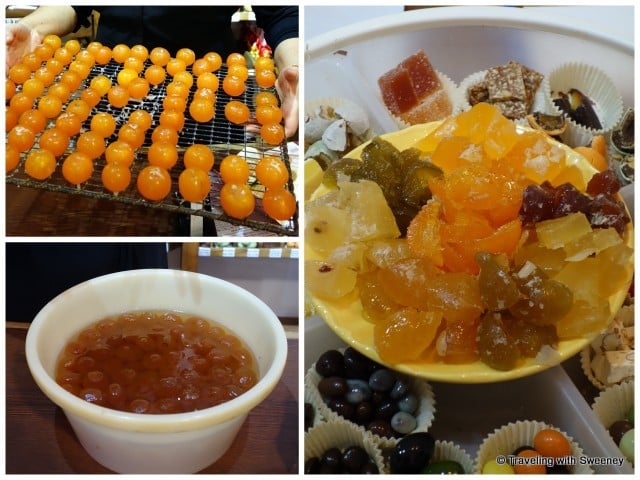
- Candied fruit, a very important and beautiful part of the desserts. At the Confiserie Saint Denis in Les Beaumettes, a village near Cavaillon, and at Pâtisserie Jouvaud in Carpentras, we not only sampled a few pieces of delicious and very sweet crystallized fruit but also talked to the candy-makers about the long process involved, one that dates back to Roman times. The fruit is soaked in sugar syrup for about one month during which time it’s boiled and cooled seven times. It then remains in the syrup for at least two more months. Each of the different fruits has a slight variation of the preparation before the first immersion. When removed, it’s dipped in a high sugar concentration syrup and then dried.
- Chocolate truffles
- Quince jam
- Bugnes (merveilles, oreillettes), fritters, little orange blossom infused doughnuts
- Milk shortbread
- Almond cake
- Dates stuffed with almond paste
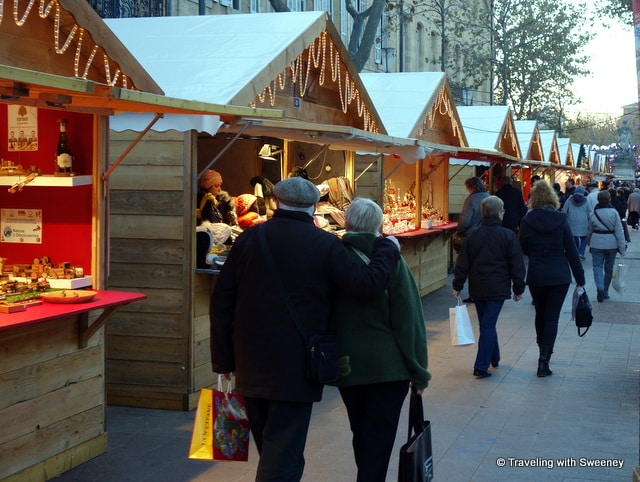
Christmas markets, plays, and fairs
There are fresh produce and craft markets year-round throughout Provence, but starting in late November (and ending in early January), local producers selling hand-crafted goods, specialty food items and decorations are brought together for Christmas markets in many Provençal cities.

Compared to other seasonal traditions, Christmas markets in Provence are relatively new (about 15 years old). Differing from ones we have seen in other areas of Europe, they are smaller, but there are plenty of food, drink, crafts, and activities. Hot wine (as well as local wines) and other beverages, sausages, cheese, candy, pastries, and other local delicacies are served. The markets seemed less boisterous than some we’ve observed elsewhere, yet the ambiance was still lively and full of Christmas spirit.
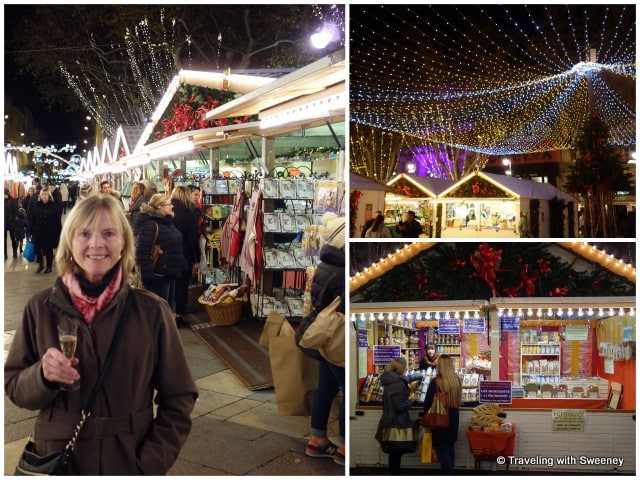
Christmas markets in Avignon cover several town squares, including the Place de l’Horloge, with over 40 chalets of crafts, decorations, textiles, jewelry, figurines, nougats, chocolate, and wine. I’ve tasted my share of hot wines (vin chaud in France) at Christmas markets, but it was a nice change of pace to have champagne as an option while strolling the chalet booths in Avignon.
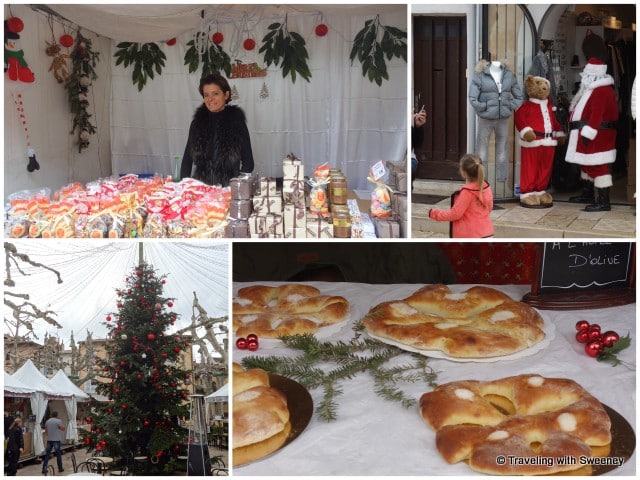
In the seaside village of Cassis, at a small, beautiful Christmas market in a lovely setting in the old town near the port, we relaxed with a hot wine and took in the scene as activity at the market got started and the aromas of cooking sausages arose. We were also served a fine regional red wine from the vineyards of Domaine Saint-Louis Jayne by vintner Laurent Jayne, who took a break from cooking up sausages at another booth to talk to us.
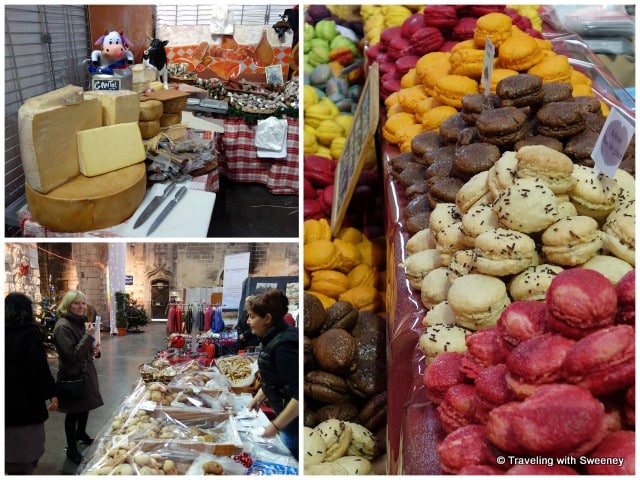
Inside the Frères Prêcheurs church of Arles, there was plenty of cheese, pastries, clothing, and decorations for sale at a three-day Christmas market charity event organized by the Kiwanis.
At many of the markets, there was entertainment for the children, too: Santa Claus, plays, balloon artists, storytellers, carousels, other rides, and ice skating.
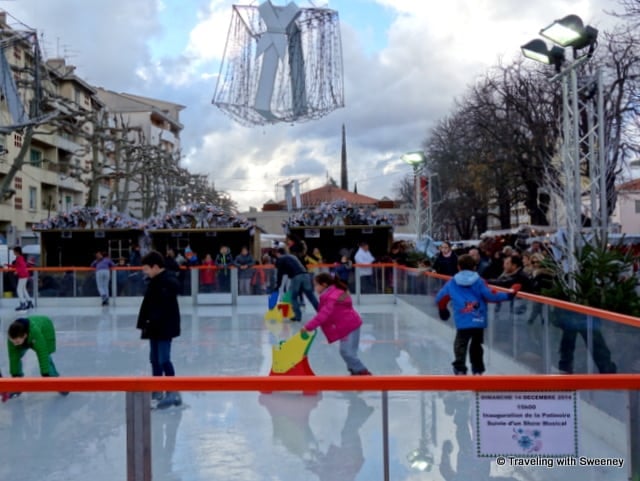
Fairs, street performances, story-telling events, pastoral plays, traditional dancing, and music draw crowds to cities such as the Drôles de Noëls (with circus performers, singers, puppeteers, magicians, theatre and firework displays) in Arles. At Bravade Calendale in Aix-en-Provence, more than 250 people participated in costume at the parade and festivities this year (photo shown at the top of the post). This annual event in Aix draws thousands of spectators.
Ceremonies and culinary traditions of Christmas Eve
As with so many Provençal traditions, there is religious symbolism mixed in with the folkloric rituals. One ritual begins the Christmas Eve activities with the oldest family member selecting a lit candle and walking backward with it toward the rest of the family. According to tradition, if the flame lies flat, the harvest will be good. If it lies upright, the crops will fail.
Another ritual, Cacho-Fio, involves lighting the Yule log. The oldest and youngest family members pour mulled wine over the log three times, place it in the fireplace, and then light it as they repeat a chant that expresses joy and thankfulness to God for the celebration and adds a request for the new year, concluding with the loosely-translated line “Let us have no less if we are to have no more.”
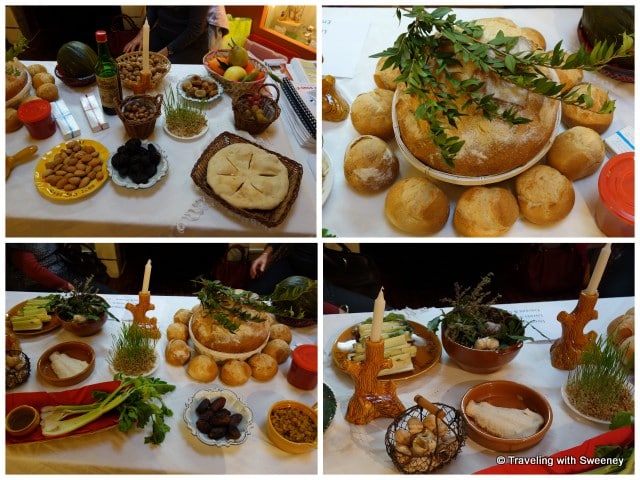
Then it’s time for the special Christmas Eve dinner, called Le Gros Souper—which translates to “grand supper.” It requires considerable preparation for the many dishes. The table is set with three white tablecloths and three candles representing the Holy Trinity. On the table and eaten with the meal are 13 loaves of bread that symbolize the Last Supper of Jesus (represented by one large loaf) and the 12 apostles (12 smaller loaves).
The meal includes seven dishes to symbolize the seven wounds of Christ (or seven sorrows of the Virgin Mary; we heard both interpretations). They include no meat and vary within Provence according to local traditions, which tend to favor utilizing produce local to the village or area. For example, near the sea, fresh fish dishes are common; further inland, dishes are vegetable-based, and in the mountains a key dish is made of a local pasta. A place is also symbolically set for a stranger in need, known as “the poor man’s seat,” in keeping with Christmas as the season of charity.
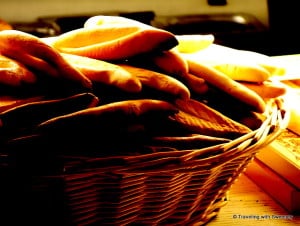
The celebrations end
The season officially ends on Candlemas, February 2nd (liturgical date of the purification of the Virgin Mary), with festivities after Mass, which include indulging in navettes, biscuits that represent the row boat in which it is believed that Mary Magdelene arrived in Provence from Israel in 40 AD. This is also the day that nativity scenes are taken down.
The people, places, holiday spirit, and cultural traditions of an authentic Provençal Christmas left a lasting impression on us.
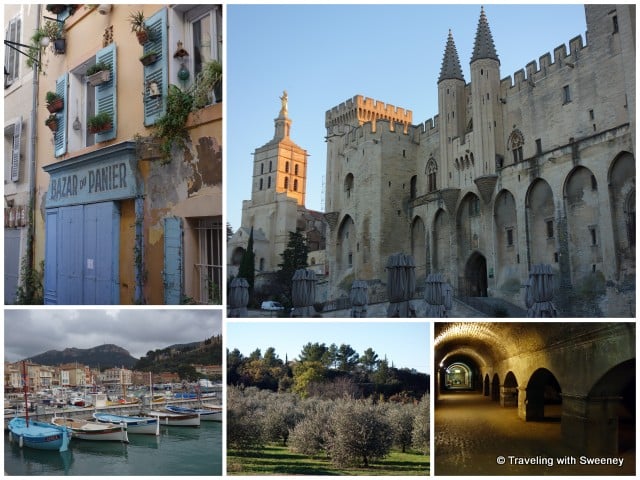
Explore more
During our trip, we were also introduced to many highlights of Provençal culture, food, wine, arts, and history that make the region a fascinating destination. Don’t miss them if you’re in Provence in winter—or any time of year.
- In Aix-en-Provence, follow in the footsteps of Cezanne to his homes and studio, walk “the city of a thousand fountains”, admire the fine art of the Granet Museum, and take in a ballet or concert at the Grand Theatre de Provence.
- In Arles, go underground into the Cryptoportico (the foundation of the ancient Roman Forum), imagine the gladiators at the Roman Arena, and get artistically inspired in this city of Van Gogh.
- In Aubagne, visit the ceramics shops and go inside the world of filmmaker Marcel Pagnol as you walk in the city and hike in the surrounding areas.
- In Avignon, explore the Palais des Papes, the largest Gothic palace in Europe and a UNESCO World Heritage site where the popes lived in the 14th century), visit the Pont d’Avignon (ancient Bridge St. Benezet), and shop at Les Halles covered market.
- In Cassis, tour the vineyards and enjoy the area’s crisp white wines; stop in the shops of the old town; sail in the Calanques (coastal fjords); explore, hike above, or climb the highest sea cliffs in Europe; and take time to relax in the Mediterranean village ambiance.
- In Gordes, near Cavaillon, get a taste of the olives and oils from olives grown in the beautiful groves Le Clos des Jeannons.
- In La Ciotat, “the cradle of cinema” where the Lumiere Brothers made their first film (Train Pulling into a Station) in 1895, walk along the promenade and stop to gaze at the Mediteranean (and a few surfers, even in winter).
- In Marseille, the 2013 European Capital of Culture, visit the MuCEM (Museum of the Civilizations of Europe and the Mediterranean) and Musée Regards de Provence for artistic, cultural, and musical heritage; explore the galleries and shops in Le Panier historic district; and capture the stunning views from the Basilica Notre Dame de la Garde.
- In Salon-de-Provence, explore the Château de l’Empéri (the 9th-century castle built on the rock of Puech) and visit the home of Nostradamus, Musée Grévin (with its depictions of the legends of Provence), and other museums.
- Everywhere, savor regional cuisine from fresh seafood to hearty beef and game dishes and stroll the historic old towns of these cities and villages.
- By the way…if you ski, head to the resorts of the southern French Alps and Mont Ventoux! Another reason that we’d like to return.





Beautiful post with a thorough list of Christmas tradition. I had no idea that Poland shares with France St. Barbara feast. Who would have thought? Although this is the same saint we have a very different tradition: it is a feast of miners in Poland because she is their patron. The feast is called Barbórka and has nothing to do with Christmas. I love these stories!
What an enchanting and positively delicious read – a feast for all senses!! Love the sweet tradition of the Thirteen Desserts. I love learning about new Christmastime traditions! Thank you for such a wonderful read!!
On my list for next Christmas !